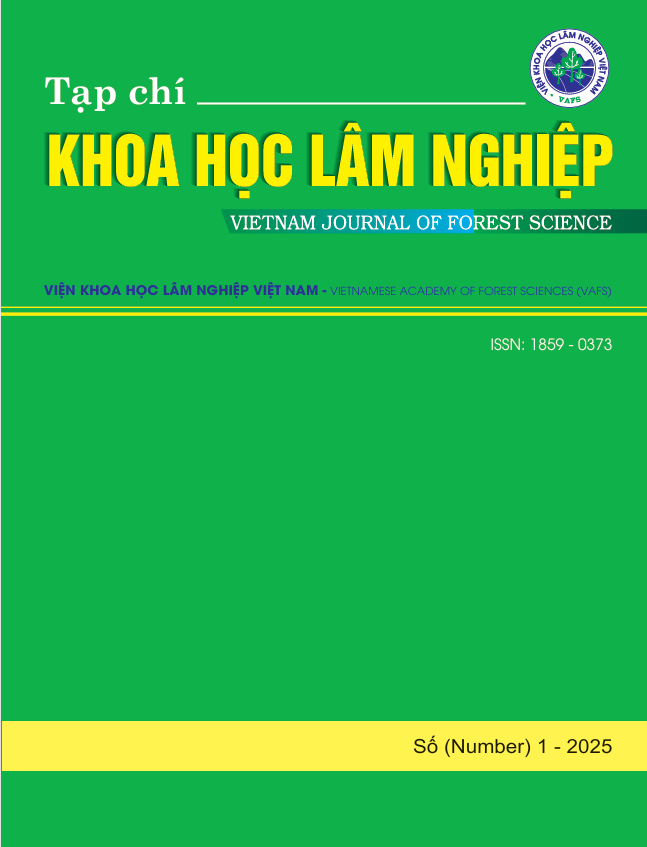NGHIÊN CỨU XÁC ĐỊNH THÀNH PHẦN TINH DẦU THẢO QUẢ (Amomum aromaticum Roxb.) TẠI MỘT SỐ TỈNH MIỀN NÚI PHÍA BẮC
DOI:
https://doi.org/10.70169/VJFS.988Từ khóa:
Amomum aromaticum Roxb, cineol, decenal, geranial, tinh dầu, Thảo quảTóm tắt
Cây Thảo quả thuộc chi Amomum, họ Zingiberaceae được Roxb (1820) đặt tên là Amomum aromaticum Roxb. được trồng nhiều ở các tỉnh miền núi phía Bắc của Việt Nam. Thảo quả là một trong những loài được sử dụng nhiều trong ẩm thực, công nghệ thực phẩm, mỹ phẩm và cũng là loài cây dược liệu có giá trị và thương mại cao trên thị trường trong nước và quốc tế. Thảo quả ở Việt Nam có chứa từ 1,5 - 2% tinh dầu. Trong đó thành phần chính của tinh dầu là 1,8 cineol ≈ 30,61%, trans-2 undecanal ≈ 17,33%, citral B (geranial) ≈ 10,57%, terpineol ≈ 4,34%. Việc nghiên cứu thành phần tinh dầu Thảo quả được thực hiện từ phân tích 36 mẫu quả Thảo quả được thu hái từ 36 ô tiêu chuẩn tại các tỉnh Lào Cai, Yên Bái và Lai Châu. Bằng phương pháp chưng cất lôi cuốn hơi nước, nghiên cứu đã thu nhận được tinh dầu Thảo quả tại Lào Cai (08 mẫu), Yên Bái (07 mẫu), Lai Châu (21 mẫu) phục vụ phân tích xác định thành phần và hàm lượng các chất trong tinh dầu. Bằng phương pháp sắc ký khí ghép nối khối phổ (GC/MS) đã xác định được 30 thành phần có trong tinh dầu Thảo quả, trong đó các thành phần chính trong các mẫu tại các tỉnh: Lào Cai là cineol 1,8 (28,8%), decenal (14,73%) và geranial (14,52%); Yên Bái là cineol 1,8 (28,98%), decenal (14,88%) và geranial (14,05%); Lai Châu là cineol 1,8 (28,84%), decenal (14,45%) và geranial (14,27%).
Tài liệu tham khảo
Võ Văn Chi, 1999. Từ điển cây thuốc Việt Nam, NXB Y học, Hà Nội.
Lê Trần Đức, 1997. Cây thuốc Việt Nam, NXB Nông nghiệp, Hà Nội.
Lê Văn Thành, 2006. Nghiên cứu một số đặc điểm sinh thái và kỹ thuật gây trồng Thảo quả (Amomum aromaticum. Roxb.) ở một số tỉnh miền núi phía Bắc làm cơ sở đề xuất kỹ thuật trồng và phát triển mở rộng, Luận văn Thác sĩ khoa học Lâm nghiệp, Trường Đại học Lâm nghiệp, 78 trang.
Tiêu chuẩn TCVN 7039:2013 (ISO 6517:2008)
Đỗ Tất Lợi, 2014. Những cây thuốc và vị thuốc Việt Nam. Nhà xuất bản Y học, 409-410.
Pruthi J.S., 1993. Major Spices of India – Crop Management and Post Harvest Technology. ICAR Publications, New Delhi, pp. 114–79.
Cui, Q., Wang, L.T., Liu, J.Z., Wang, H.M., Guo, N., Gu, C.B. and Fu, Y.J., 2017. Rapid extraction of Amomum tsao-kho essential oil and determination of its chemical composition, antioxidant and antimicrobial activities. Journal of Chromatography B, 1061-1062, 364-371
Bộ Y tế, 2017. Dược điển Việt Nam V.
Bộ Y Tế, 2018. Phương pháp chế biến đông dược. In Dược điển Việt Nam. Hà Nội: NXB Y Học.
Diao, W.R., Zhang, L.L., Feng, S.S. and Xu, J.G., 2014. Chemical composition, antibacterial activity, and mechanism of action of the essential oil from Amomum kravanh. Journal of Food Protection, 77 (10), 1740-1746
Nguyễn Văn Lợi, Nguyễn Thị Thu Hiền, Phạm Thị Bình, 2020. Xây dựng quy trình sản xuất tinh dầu từ quả thảo quả Hà Giang. Tạp chí Nông nghiệp và PTNT, 21, 55-62.
Loi NV. and Binh PT, 2022. Study on the components and biological properties of the essential oil of Amomum aromaticum Roxb. in Ha Giang, Vietnam. Food Research 6(5): 390 - 393













